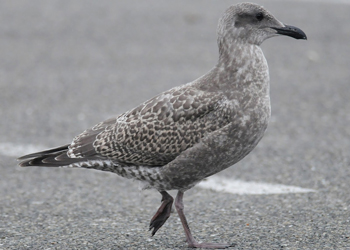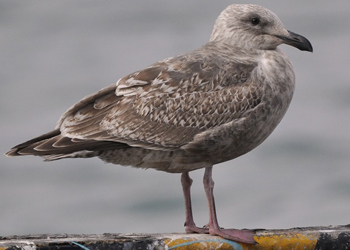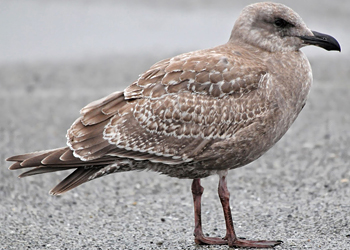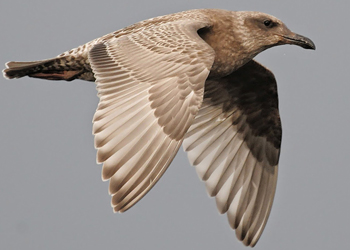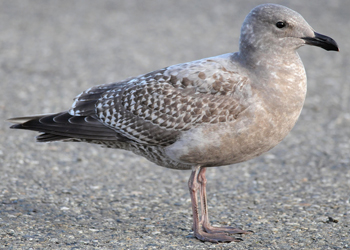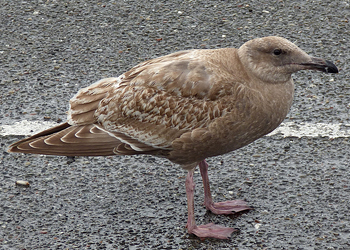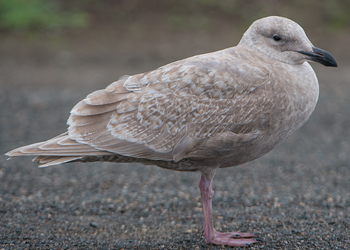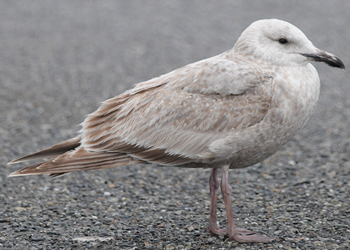 Slaty-backed Gull (schistisagus) / オオセグロカモメ / 큰재갈매기
Slaty-backed Gull (schistisagus) / オオセグロカモメ / 큰재갈매기
(last update: December 2015)
Slaty-backed Gull (schistisagus) adult February
Identification of Slaty-backed Gull (schistisagus)
PART 1: description of adults
PART 2: description of 1st cycles (this page)
PART 3: description of 2nd cycles
PART 4:
Text from "Gulls of Europe, Asia and North America", by Malling Olsen, K. & Larsson, H. (Christopher Helm, London, 2004).
"we" in the text below refers to the original authors. If any errors occur in this text, please let me know and mail to marsmuusseatgmaildotcom.
PART 2: description of 1st cycle birds
Juvenile dark to greyish-brown with washed-out brown patterning and pale-scaled saddle; rear scapulars often with paler subterminal areas. In some, pale hindneck contrasts with darker ear-coverts and crown. Under-body brown, appearing velvety, but lower belly often pale, isolated from darker breast-bar, flanks and rather uniform dark underwing-coverts. Undertail-coverts with scattered dark markings only. Wing-tip brown with pale inner webs and edges as in first-year Thayer’s, but P9-P10 often uniform; mid-primaries with dark spots near tip, forming dark trailing edge to outer wing - from below striking in head-view. The primary pattern mirrors the ‘string of pearls’ of adults, but pale tongues on P6-P10 prominent. In flight, the hand often appears mid-brown with darker edges, and thus pale ‘window’ on inner wing of Vega and American Herring appears non-existent or at least very weak. Secondaries create dark trailing edge to inner wing and show white tips. Coverts brown, lesser coverts with pale edges, greater coverts with indistinct pale diluted markings and broader whitish tips. Outer greater coverts may be paler or darker than inner ones, but lack any strong barring.
Tertials brown with rather straight and often narrow pale edges; notching and irregular pattern reduces to tips, typically slightly paler than wing-tip but darker than mantle. Tail black to dark brown, together with dark-barred or -spotted rump creating dark ‘rear’ typical for W American gulls, but unlike Vega Gull. Tail sometimes with fine white mottling at base and along edges, just visible at close range. Bill black. Legs pink.
First-winter similar to juvenile, but generally with paler chin, throat and hindneck, isolating dark head as hood, half-hood or even mask. Mantle and scapulars with scattered new grey to greyish-brown feathers, showing blackish triangles, fine blackish anchor-markings, subterminal bars or shaft-streaks and pale tips. Juvenile wing often fades quickly from first-autumn, being strongly worn from Feb. Bare parts as juvenile, but base of bill and sometimes line along lower mandible may be dull fleshy and legs often rosy.
First-year Vega Gull browner with paler head and blackish wing-tip in better contrast to paler window. Lacks pale inner webs and line of spots on outer wing. Mantle and scapulars look barred, as dark subterminal bars are stronger. Greater coverts more strongly patterned, with more distinct pale and dark bars in better contrast to darker secondaries. Tertials blackish with pale notching along sides, concolorous with wing-tip. Rump whitish with dark barring against whitish tail-base and broad black tail-bar.
From Feb/ Mar juvenile coverts and rump fade to almost whitish in contrast to dark tail and subterminal markings on inner primaries. Some show brown outer primaries, appearing concolorous with, or sometimes paler than, tertial centres. Separated from American Herring and Vega Gulls by solid brown tail and paler brown flight feathers with obvious streaked and ‘dotted’ appearance to outer wing. Eye becomes paler from Feb.
By first-summer white-headed and often with very bleached wing. Bill often appears bicoloured, but some remain black-billed. During moult in summer shows very good contrast between bleached areas and fresh dark feathers of second-winter.
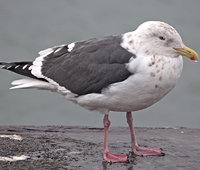 Slaty-backed Gull (schistisagus) adult, February 19 2014, Akkeshi, Hokkaidoi, Japan.
Slaty-backed Gull (schistisagus) adult, February 19 2014, Akkeshi, Hokkaidoi, Japan.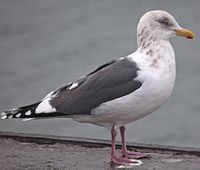 Slaty-backed Gull (schistisagus) adult, February 19 2014, Akkeshi, Hokkaidoi, Japan.
Slaty-backed Gull (schistisagus) adult, February 19 2014, Akkeshi, Hokkaidoi, Japan. Slaty-backed Gull (schistisagus) adult, February 14 2013, Hwajinpo, South Korea. Picture: Tom Lindroos.
Slaty-backed Gull (schistisagus) adult, February 14 2013, Hwajinpo, South Korea. Picture: Tom Lindroos.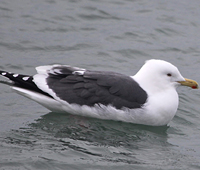 Slaty-backed Gull (schistisagus) adult, February 19 2014, Akkeshi, Hokkaidoi, Japan.
Slaty-backed Gull (schistisagus) adult, February 19 2014, Akkeshi, Hokkaidoi, Japan. Slaty-backed Gull (schistisagus) adult, February 22 2014, Choshi, Chiba, Japan. Picture: Shiroto.
Slaty-backed Gull (schistisagus) adult, February 22 2014, Choshi, Chiba, Japan. Picture: Shiroto.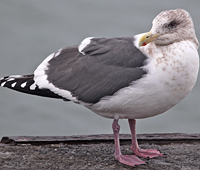 Slaty-backed Gull (schistisagus) adult, February 19 2014, Akkeshi, Hokkaidoi, Japan.
Slaty-backed Gull (schistisagus) adult, February 19 2014, Akkeshi, Hokkaidoi, Japan.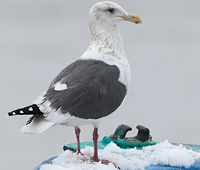 Slaty-backed Gull (schistisagus) adult, February 14 2013, Hwajinpo, South Korea. Picture: Tom Lindroos.
Slaty-backed Gull (schistisagus) adult, February 14 2013, Hwajinpo, South Korea. Picture: Tom Lindroos. Slaty-backed Gull (schistisagus) adult, February 21 2014, Choshi, Chiba, Japan. Picture: Shiroto.
Slaty-backed Gull (schistisagus) adult, February 21 2014, Choshi, Chiba, Japan. Picture: Shiroto. Slaty-backed Gull (schistisagus) adult, February 15 2014, Choshi, Chiba, Japan. Picture: Shiroto.
Slaty-backed Gull (schistisagus) adult, February 15 2014, Choshi, Chiba, Japan. Picture: Shiroto. Slaty-backed Gull (schistisagus) adult, February 16 2014, Choshi, Chiba, Japan. Picture: Shiroto.
Slaty-backed Gull (schistisagus) adult, February 16 2014, Choshi, Chiba, Japan. Picture: Shiroto. Slaty-backed Gull (schistisagus) adult, February 24 2014, Choshi, Chiba, Japan. Picture: Shiroto.
Slaty-backed Gull (schistisagus) adult, February 24 2014, Choshi, Chiba, Japan. Picture: Shiroto. Slaty-backed Gull (schistisagus) adult, February 21 2014, Choshi, Chiba, Japan. Picture: Shiroto.
Slaty-backed Gull (schistisagus) adult, February 21 2014, Choshi, Chiba, Japan. Picture: Shiroto. Slaty-backed Gull (schistisagus) adult, February 17 2014, Choshi, Chiba, Japan. Picture: Shiroto.
Slaty-backed Gull (schistisagus) adult, February 17 2014, Choshi, Chiba, Japan. Picture: Shiroto. Slaty-backed Gull (schistisagus) adult, February 20 2014, Choshi, Chiba, Japan. Picture: Shiroto.
Slaty-backed Gull (schistisagus) adult, February 20 2014, Choshi, Chiba, Japan. Picture: Shiroto.




